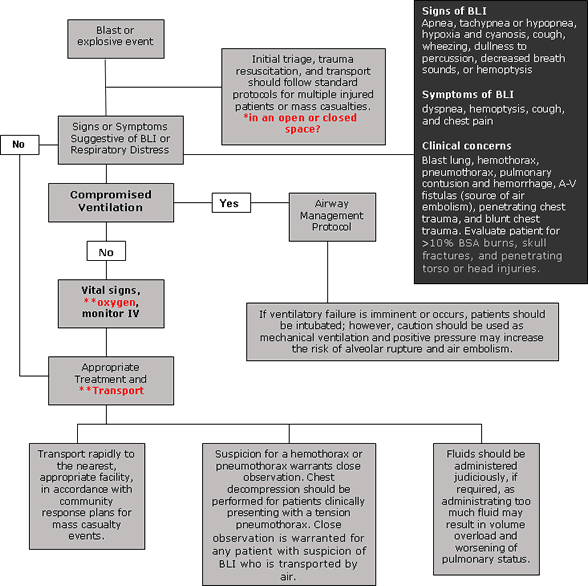Blast Lung Injury: Prehospital Care
Current patterns in worldwide terrorist activity have increased the potential for casualties related to explosions, yet few civilian emergency medical service providers in the United States have experience treating patients with these injuries. One direct consequence of high-explosive detonations upon the body is blast lung injury—or, BLI. It is characterized by respiratory difficulty and hypoxia. BLI can occur, although rarely, without obvious external chest injury. Persons in enclosed-space explosions or in close proximity to the explosion are at highest risk. BLI presents unique triage, diagnostic, and management challenges.
Clinical Presentation
- Symptoms may include dyspnea, hemoptysis, cough, and chest pain.
- Signs may include tachypnea, hypoxia, cyanosis, apnea, wheezing, decreased breath sounds, and hemodynamic instability.
- Victims with skull fractures, injuries penetrating torso or head, or burns covering more than 10% body surface area (BSA) are more likely to have BLI.
- Hemothoraces or pneumothoraces may occur.
- Due to pulmonary or vascular tearing, air may enter the arterial circulation (air emboli) and result in embolic events involving the central nervous system, retinal arteries, or coronary arteries.
- Clinical evidence of BLI is typically present at the initial evaluation; however, reports show that evidence of BLI can appear 24 to 48 hours after an explosion.
- Other injuries are often present.
Prehospital Management Considerations
- Initial triage, trauma resuscitation, and transport of patients should follow standard protocols for multiple injured patients or mass casualties.
- Explosions in confined spaces result in a higher incidence of primary blast injury, including lung injury. Note the patient’s location and the surrounding environment at the time of injury.
- Patients with suspected or confirmed BLI should receive supplemental high-flow oxygen to prevent hypoxemia.
- A compromised airway requires immediate intervention.
- If ventilatory failure is imminent or occurs, patients should be intubated; however, prehospital providers must realize that mechanical ventilation and positive pressure may increase the risk of alveolar rupture, pneumothorax, and air embolism in BLI patients.
- High-flow oxygen should be administered if air embolism is suspected, and the patient should be placed in a prone, semi-left lateral, or left lateral position.
- Clinical evidence or suspicion of a hemothorax or pneumothorax warrants close observation. Chest decompression should be performed for patients clinically presenting with a tension pneumothorax. Close observation is warranted for any patient suspected of BLI who is transported by air.
- Fluids should be administered judiciously, as overzealous fluid administration in the patient with BLI may result in volume overload and worsen pulmonary status.
- In accordance with community response plans for mass casualty events, patients with BLI should be rapidly transported to the nearest appropriate facility.
- Patients with BLI should be transported rapidly to the nearest, appropriate facility, in accordance with community response plans for mass casualty events.
Blast Lung Injury Management Protocol

*There is a higher incidence of BLI in enclosed spaces.
**High flow oxygen, airway management as appropriate, evaluate for additional injury and rapid transport.
Contact Us:
- Centers for Disease Control and Prevention
1600 Clifton Rd
Atlanta, GA 30333 - 800-CDC-INFO
(800-232-4636)
TTY: (888) 232-6348 - Contact CDC-INFO




